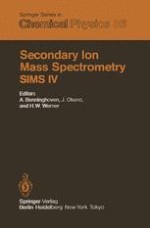1984 | OriginalPaper | Chapter
Comparison of Three Source Geometries for Cs+ Liquid SIMS
Authors : W. Aberth, R. Reginato, A. L. Burlingame
Published in: Secondary Ion Mass Spectrometry SIMS IV
Publisher: Springer Berlin Heidelberg
Included in: Professional Book Archive
Activate our intelligent search to find suitable subject content or patents.
Select sections of text to find matching patents with Artificial Intelligence. powered by
Select sections of text to find additional relevant content using AI-assisted search. powered by
In the typical liquid SIMS (LSIMS) geometry, the primary beam direction is fixed at 90° to that of the secondary ion beam, and the secondary signal is optimized by varying the target plane angle. Best results are often obtained at an incident angle of 60° [1]. It can be argued that this large angle improves secondary ion efficiency because a greater portion of the incident ion energy is deposited close to the target surface where it can more effectively cause secondary ion ejection [2]. However, the complementary extraction angle for the secondary ions must then be small and ambiguity exists as to the most effective independent combination of incident and secondary ion beam angles [3]. It has been suggested that the greater efficiency of high-mass ion production using the plasma desorption technique may be partly due to the similarity in direction of the primary and secondary beams [4]. Thus some of the momentum of the primary beam assists in extracting the sample ion from the target matrix. These considerations motivated us to try alternate LSIMS source configurations that could permit sampling of ions ejected close to the direction of the primary beam. The small size of the cesium ion gun used for LSIMS [5,6] provided a flexibility of orientation not generally available to FAB and other types of ion sources.
